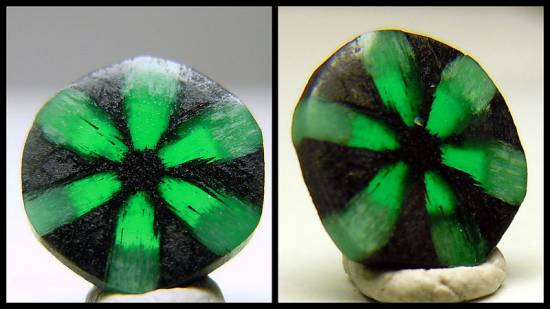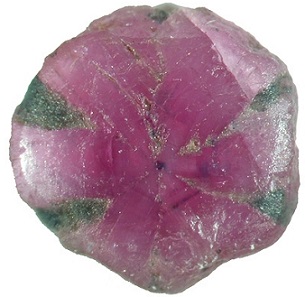Trapiche gemstones satiate our brain’s desire for symmetry. The delightful geometry of their rayed pattern appeals to our intellect. They are among the most spectacular stones in the gem kingdom.
Trapiche Emerald Gemstone
Image Source: https://commons.wikimedia.org/wiki/File:Trapiche_emerald.jpg
1) Origins Of The Gem’s Name:
The name of this gem owes its origins to the trapiche wheel. Trapiche de caña de azúcar is Spanish for a six-spoked cogwheel. The wheel is turned by bulls tied to a yoke to crush sugarcane.
2) Physical Description:
Coming back to our gem. Six arms of inclusions sandwiched between growing mineral sections extend outwards in the gem. And these resemble the spokes of a trapiche wheel.
Trapiche minerals are instantly recognisable by their conspicuous growth sectors. These sectors are geometrically equivalent and are separated by bands of inclusions. The shadowy inclusion bands either intersect at a central point or extend from the edge of a central core. The gems are often cut as cabochons to show off the six partitions.
The peculiar geological conditions that create such gems are not very common. Consequently, trapiche gemstones are incredibly uncommon.
We don’t know much about these gems because of their relatively recent discovery. The rarity of the gem further adds to its mystique.
Trapiche Ruby Gemstone
Image Source: https://commons.wikimedia.org/wiki/File:Corundum_(Variety_trapiche_ruby)-484429.jpg
3) Trapiche Gems: What are they?
Don’t confuse them with star gems. Trapiche gems form with a central nucleus and six radiating arms of inclusions. These arms are wedged between sectors of growing gem material. Some of the stones do not display the core. The arms originate directly from the centre of the gem and criss-cross each other.
Branching-tree-like crystalline structures (black shale dendrites) might also form in the vicinity of the arms and the core.
On the other hand, star-gems flash their stars on account of light bouncing off inclusions within the gem mineral. There are no distinct growth sectors of minerals here. Also, the inclusions have to be arranged in a particular manner for the star to come to light. The phenomenon in this case is known as asterism.
Only minerals with a highly symmetrical crystalline lattice have been seen to generate the “spokes” or “arms” that characterize a trapiche gem.
4) Minerals Capable of forming Trapiche Gems?
The French mineralogist Emile Bertrand in 1879, first documented a trapiche emerald. It was excavated from the Muzo mines in Colombia. In fact, emeralds present the best specimens of trapiche gemstones.
More than a hundred years later, in 1995, Mong Hsu mine of Myanmar reported the discovery of trapiche rubies. And just a year later, trapiche sapphires made their appearance. Since then, gem experts have corroborated the existence of trapiche aquamarine, spinel, garnet, tourmaline and quartz.
5) Geological Conditions Creating Trapiche Gems:
This maverick gem needs peculiar geological conditions to concoct its fascinating steering-wheel like shape. Trapiches develop when carbon-rich bedrock gets inundated with geothermal waters. The brime is brimming with chemicals that can trigger gem formation. The drying aquae precipitates into seed crystals. Furthermore, zoning starts occurring within the bounds of the growing gem. The gem mineral grows only along smooth faces. And it pushes and compresses the inclusion bands as it grows. This causes equivalent growth-faces that we cherish in trapiche stones.
The same hydrothermal conditions that create the gemstone emerald also create Trapiche emeralds. The latter however, has a much more arduous history. It involves fluctuations in fluid pressures in the structural geology of the deposits. Hexagonal symmetry of the crystalline lattice creates six arms.
6) The Type A and Type B Trapiche Gems
Virtually all trapiche stones show gem material growing in sectors between thick arms of inclusions. These are the “type A” or “standard” trapiche gems. And yet, certain other stones show inclusions growing in sectors between thick arms of gem mineral. Such gems are exceedingly rare. They are called “Type B” or reverse trapiches.
7) Trapiche Lookalikes:
True trapiche gemstones hold thickset inclusions in between growth sections. But certain gems are able to display “trapiche-like” imitations due to color zoning. Such facsimiles may also appear on account of profusion of inclusions within the crystal-body. In such cases, the crystal is continuous without any breaks.
By contrast, the mineral is split into sectors in a true-trapiche. And each sector grows independently of the other. Nevertheless, such mimicking gems do display similar stunning symmetry. Moreover, it has been seen that the minerals that yield trapiches are also capable of exhibiting trapiche-like color zones.
The star, displayed by light bouncing off aligned inclusions within the crystal body, glides on the surface of the gem. This happens with any movement of the gem or the light source. But the arms of trapiche gems remain stationary even with any kind of movement.
The natural geometric pattern of a trapiche gemstone can get the creative juices of a jewelry designer flowing. And the epic emerald yields the most resplendent trapiches.

